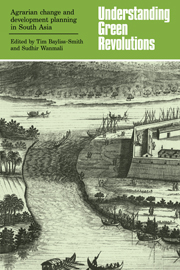Book contents
- Frontmatter
- Contents
- List of contributors
- Preface
- I Understanding Green Revolutions: an overview
- II Agrarian change at village level
- 5 Agrarian policy and agrarian change in tribal India
- 6 Migration and agrarian change in Garhwal District, Uttar Pradesh
- 7 Agricultural development in Tamil Nadu: two decades of land use change at village level
- 8 Energy flows and agrarian change in Karnataka: the Green Revolution at micro-scale
- 9 Income and wealth disparities in a land settlement of the Sri Lanka Dry Zone
- 10 Agrarian structure and agricultural innovation in Bangladesh: Panimara village, Dhaka district
- 11 A structural analysis of two farms in Bangladesh
- III Development planning and agrarian change
- Index
5 - Agrarian policy and agrarian change in tribal India
Published online by Cambridge University Press: 25 May 2010
- Frontmatter
- Contents
- List of contributors
- Preface
- I Understanding Green Revolutions: an overview
- II Agrarian change at village level
- 5 Agrarian policy and agrarian change in tribal India
- 6 Migration and agrarian change in Garhwal District, Uttar Pradesh
- 7 Agricultural development in Tamil Nadu: two decades of land use change at village level
- 8 Energy flows and agrarian change in Karnataka: the Green Revolution at micro-scale
- 9 Income and wealth disparities in a land settlement of the Sri Lanka Dry Zone
- 10 Agrarian structure and agricultural innovation in Bangladesh: Panimara village, Dhaka district
- 11 A structural analysis of two farms in Bangladesh
- III Development planning and agrarian change
- Index
Summary
There has not been a Green Revolution to speak of in tribal India – certainly not in tribal Bihar. It is of course true that a number of individuals in Bihar's tribal belt have introduced improved varieties of seeds and have begun to apply chemical fertilisers to their crops, but this has not been a general trend (Table 5.1). It should be emphasised that this has little to do with any cultural backwardness or with any lack of an entrepreneurial spirit amongst the tribals of the Jharkhand. It simply reflects the constraints imposed by the region's geology. The absence of suitable groundwater supplies means that tubewell irrigation – so much the precondition for the Green Revolution in the rest of India – is impracticable over much of the region.
Yet this failure to undergo a Green Revolution has not been without certain ironic consequences. For whilst it is now well established, not least by Benny Farmer (1977) and his co-workers, that the Green Revolution has succeeded more in differentiating the peasantry than in raising the living standards of the rural poor, it is true also that these and other findings are beginning to encourage the Indian Government towards a reappraisal of its agrarian policies. No longer can it be taken for granted that agricultural development can be secured by pumping a range of agricultural-inputs and techniques into essentially undifferentiated rural ‘communities’ or ‘peasantries’. The literature on the Green Revolution has finally scotched the belief that such communities exist – at least in caste India. Unfortunately no such lesson has been learnt by the planners responsible for India's tribal areas.
- Type
- Chapter
- Information
- Understanding Green RevolutionsAgrarian Change and Development Planning in South Asia, pp. 87 - 108Publisher: Cambridge University PressPrint publication year: 1984
- 2
- Cited by



